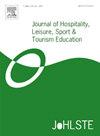Experiences of athletes in a simulation based applied sports science university assessment: Identifying areas for improvement
IF 4.1
2区 教育学
Q1 EDUCATION & EDUCATIONAL RESEARCH
Journal of Hospitality Leisure Sport & Tourism Education
Pub Date : 2025-01-09
DOI:10.1016/j.jhlste.2025.100535
引用次数: 0
Abstract
It is imperative that university assessments have high levels of academic rigour, it is also important that they are ecologically valid and prepare students for employment in the relevant sectors post study. As such, within a practical based subject like strength and conditioning, academic staff have designed assessments to reflect industry relevant activities such as athlete testing, data interpretation and communicating relevant information to the athlete. To improve this process, it is important to act upon feedback from key stakeholders in the assessment process, such as the external athletes involved in this specific assessment. The purpose of this analysis was to obtain feedback from the athletes the students worked with in the assessment process with a view to improving future iterations. Following the assessment all athletes involved completed a short interview and filled out a questionnaire which contained fixed response and open-ended questions on their opinions and experiences of the assessment. All athletes who participated stated they would be willing to be involved in future years, all athletes also stated that the assessment was very industry relevant and commended its inclusion within the programme. Areas for improvement were identified, athletes felt that the assessor should be less present to facilitate more organic interactions between the students being assessed and the athlete. The assessment was perceived as a positive experience for external athletes involved, who all believed the process mirrored experiences from their athletic careers. For future assessments staff should devise strategies to be less visible to allow more natural interactions between students and athletes.

运动员在基于模拟的应用体育科学大学评估中的经验:确定改进的领域
大学评估必须具有高水平的学术严谨性,同样重要的是,它们在生态上是有效的,并为学生毕业后在相关部门的就业做好准备。因此,在像力量和体能这样的实践性学科中,学术人员设计了反映行业相关活动的评估,如运动员测试、数据解释和向运动员传达相关信息。为了改进这个过程,根据评估过程中关键利益相关者的反馈采取行动是很重要的,比如参与这个特定评估的外部运动员。此分析的目的是从学生在评估过程中与之合作的运动员那里获得反馈,以改进未来的迭代。在评估之后,所有参与的运动员都完成了一个简短的访谈,并填写了一份问卷,其中包含固定答案和开放式问题,关于他们对评估的看法和经历。所有参与的运动员都表示他们愿意在未来几年参与其中,所有运动员也都表示评估与行业非常相关,并赞扬将其纳入计划。确定了需要改进的地方,运动员认为评估员应该减少在场,以促进被评估学生和运动员之间更多的有机互动。对于参与评估的外部运动员来说,评估被认为是一种积极的体验,他们都认为这个过程反映了他们运动生涯的经历。在未来的评估中,工作人员应该设计出不那么显眼的策略,让学生和运动员之间有更多自然的互动。
本文章由计算机程序翻译,如有差异,请以英文原文为准。
求助全文
约1分钟内获得全文
求助全文
来源期刊
CiteScore
8.10
自引率
10.80%
发文量
41
审稿时长
42 days
期刊介绍:
The Journal of Hospitality, Leisure, Sport and Tourism Education (JoHLSTE) is the leading international, peer-reviewed educational journal for this subject grouping. Its aims are to: a) Promote, enhance and disseminate research, good practice and innovation in all aspects of higher education in Hospitality, Leisure, Sport and Tourism and Events to its prime audience including teachers, researchers, employers, and policy makers. b) Encourage greater understanding, links and collaboration across its constituent fields. JoHLSTE is designed to have maximum impact through it being available on-line, fully archived and peer-reviewed. JoHLSTE is divided into seven sections: Editorial; Academic Papers; Practice Papers, Perspectives, Comments and Rejoinders, Research Notes and Reports and Education Resource Reviews.

 求助内容:
求助内容: 应助结果提醒方式:
应助结果提醒方式:


